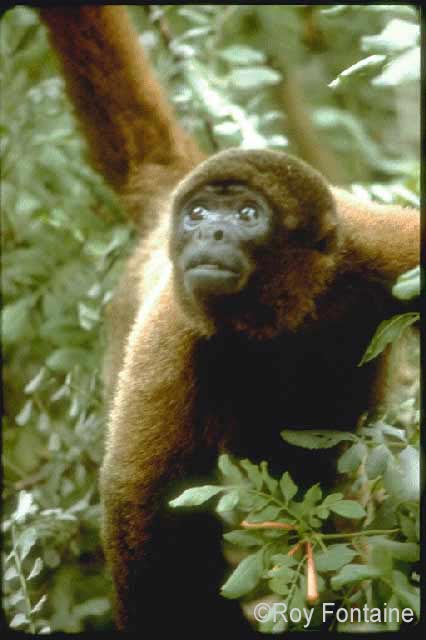Common (Humboldt’s) Woolly Monkey (Lagothrix lagotricha) Classification: Class: Mammalia, Order: Primates, Family: Cebidae, Genus: Lagothrix Species: lagotricha
IUCN Status: Vulnerable in Ecuador, Near Threatened Globally
In Ecuador, Woolly Monkeys are classified as vulnerable. Their pelage (fur) colors vary from dark brown, red-brown, gray, and olive. Their dorsal (back) sides are usually lighter than their ventral (under-belly) sides. They have black faces and the palms of their hands are a deep pink color. Their tails are long and thick and can comfortably support this species' body weight (they often hang from their tales while resting). Woolly Monkeys weigh an average of 17 pounds.
Woolly Monkeys are found throughout the northern countries of South America (Bolivia, Brazil, Colombia, Ecuador, Venezuela, and Peru). Although their ideal habitat is humid and mature tropical forests, they often inhabit high elevation cloud forests, seasonally flooded rainforests, and forests near rivers in Colombia’s eastern plains region.
This species lives in groups ranging from 10-45 individuals. Foraging groups, however, tend to consist of 2-6 individuals, which branch off from the main group into different trees. Woolly Monkeys have a diet that consists primarily of fruit, although leaves, seeds, flowers, and invertebrates are also consumed. Social organization within the larger group is organized by age, sex, activity, and the reproductive status of females. Reproduction in these groups is characterized as promiscuous. In other words, one male will generally mate with all of the females and vice-versa. Shortly after females reach maturity, they leave their natal groups (the groups where they were born) as a means of avoiding inbreeding. Males will stay in their natal groups for life.
Play, which is often used to establish social ranking, is common amongst members of this species. Passive food sharing is also common. Woolly Monkeys have elaborate systems of vocal, olfactory (scent), visual, and tactile (touching) communication. Communication can be used for coordinating group efforts as well as to indicate aggression, affection, and marking of territory.
The Woolly Monkey’s predators include several species of eagle and cats like the ocelot and jaguar. However, its main predator is humans who hunt the species both for meat and for sale as pets. It is believed that over-hunting and habitat encroachment, both caused by increasing human populations, are the key factors behind the species' recent decline. If the proposed Petrobras and other oil roads are built into the untouched areas of Yasuní, hunting of this species will be made far easier.
(http://members.tripod.com/uakari/lagothrix_lagotricha.html)
(http://www.rainforest-alliance.org/resources/forest-facts/species-profiles/tapir.html)
CLICK HERE FOR MORE EXTRAORDINARY
ANIMALS and PLANTS OF YASUNÍ,
THE MOST BIODIVERSE FOREST KNOWN ON EARTH
Yasuní Biodiversity Main Page
|

